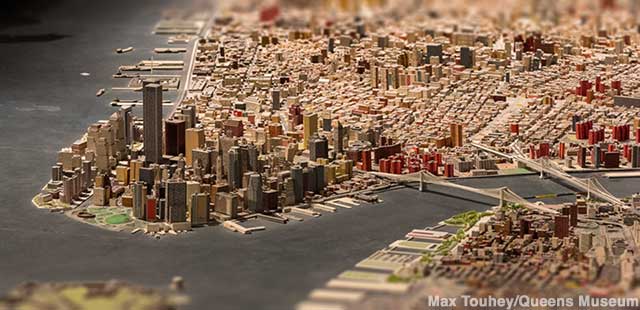
The Twin Towers of the World Trade Center still stand in this diminutive version of New York City.
Panorama of the City of New York
Queens, New York
America has been home to a lot of miniature villages -- little 3-D scale models of buildings and streets, usually hand-crafted -- but none are as big as the Panorama of the City of New York.
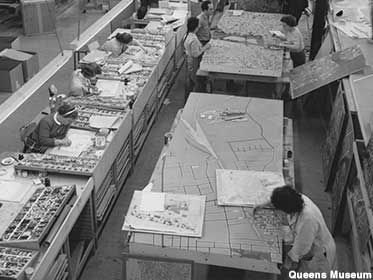
Workers labored on the Panorama for three years.
It was built for the 1964-65 New York World's Fair. The Panorama's survival, still in its same building 60 years later, is a testament to the city's fascination with itself, and to the fact that even a place as unsentimental as New York knows that it would be a shame to throw away something this big (and nice).
The Panorama was created by the firm of Lester and Associates, a company that specialized in making little versions of big things. This was the biggest little thing it ever built, covering nearly a third of an acre. It's still the world's largest architectural model (one inch on the Panorama equals 100 feet in real life), and is so accurate that it was sold to New York City's taxpayers as a future urban planning tool -- which it never became. Over 100 full-time artisans, many of them women, labored three years to craft every single building and structure in the Bronx, Queens, Brooklyn, Manhattan, and Staten Island: 830,000 tiny brownstones, bridges, stores, and skyscrapers. All of the work was done by hand.
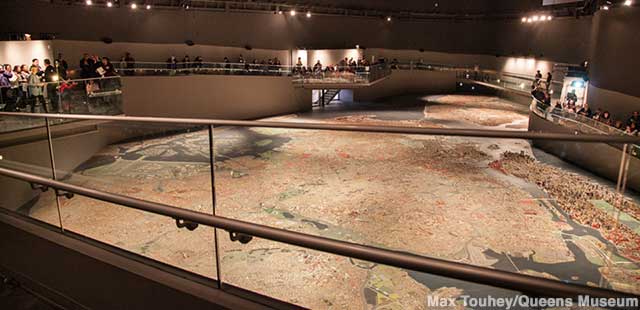
View of the Panorama from the encircling elevated walkway. Manhattan is on the right.
The Panorama was an edutainment ride when it opened at the Fair in April 1964. For only ten cents visitors could view it from little gondola pods on a motorized track as they took what was called a "helicopter tour" around the model, while a recording of narrator Lowell Thomas said things such as, "Look below you. The city of opportunity and of greatness: New York!" and rattled off a list of municipal infrastructure wonders. "186 libraries!" "459 tennis courts!" Tiny color-coded light bulbs -- over 3,100 of them -- winked on and off to illuminate firehouses, schools, and hospitals.
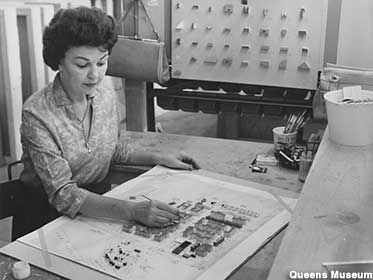
Many of the Panorama's 830,000 buildings were made by women.
The little colored lights are still there, but the ride and Lowell Thomas are gone. Visitors today experience the Panorama by self-locomotion, entering it after ascending to the second floor of what is now the Queens Museum, passing a large showcase filled with memorabilia and souvenirs from the 1964-65 Fair, including some Mold-A-Rama Sinclair Dinoland Dinosaurs and miniature models of futuristic Fair pavilions such as "Progressland" from General Electric.
A cantilevered balcony with a glass balustrade now wraps around and above the Panorama. Your first view of the immense model is over the Bronx, looking south down the length of Manhattan Island. With the exception of the distinctive green Central Park -- rectangular and skyscraperish in shape -- the city is a brown mass of concrete spreading east, unsettlingly unnatural, unless New York City happens to be your home, which it is for many Panorama visitors.
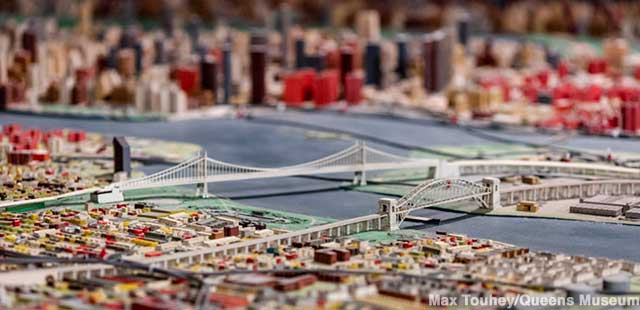
Hell's Gate and RFK bridges connect Queens to Randalls Island.
From your initial view of the model you're directed to follow the balcony walkway east over Queens, then south across Brooklyn, west to Staten Island, then north along the Hudson River side of Manhattan. Sections of the balcony have glass floors (called "Crystal Walkways") so that you can look at parts of the Panorama that would otherwise be blocked from view. It is an unapologetically New-York-City-centric perspective on the universe. Neighboring communities such as Yonkers, Hoboken, Fort Lee, and Hempstead are represented as black voids.
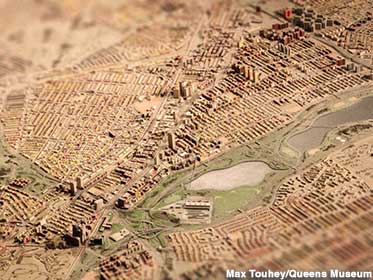
Flushing Meadows: site of the 1964-65 NY World's Fair.
Every 15 minutes the lights dim, the city is cast in a rosy glow, and night falls for 90 seconds. Because the Panorama was a pet project of then-powerful New York City planner Robert Moses, all of his parks and parkways glow with phosphorescent green paint under ultraviolet light, and when daylight returns his brick housing projects stand out in a bright, eye-catching red.
Despite their diminutive size, New York City's famous landmarks can be spotted on the Panorama (if you know where to look), such as Yankee Stadium, Coney Island's Cyclone roller coaster, the Verrazano Bridge connecting Brooklyn to Staten Island, and the itty-bitty Statue of Liberty. You can even see the former World's Fair site, with its tiny Unisphere and Queens Museum building, which is where you're standing. It may take you a while to find it; on the model it's only 4 inches long and 2 inches wide.
A display along the walkway shows how big (or small) the Panorama skyscrapers really are. The Empire State Building, for example, is about the height of two human hands placed end-to-end, wrists to fingertips. If you look closely at the city's waterways you can see the seams in the Panorama's nearly 300 formica foundation panels.
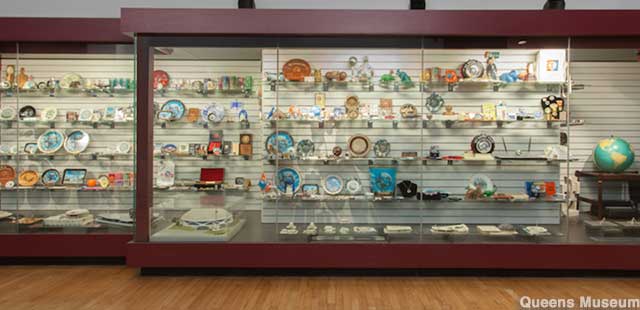
World's Fair mementoes: souvenir plates, building models, and Mold-A-Rama dinosaurs.
Every minute a tiny passenger jet on a wire "flies" into a hole at the end of a LaGuardia Airport runway, then emerges from a hole at the other end and goes airborne again. The sky above this vision of New York City is crystal-clear, the water unstained by pollution (neither of which was true in 1964). From the balcony the city looks spotless and amazing, but that's the benefit of a heavenly perspective: you're too far away to see the people and the problems.
The Panorama received occasional updates in the years following the World's Fair, although the last full remodel -- bringing the Panorama total to nearly 900,000 buildings -- was completed way back in 1994. Since then an occasional new skyscraper or municipal feature has been added, but the miniature City That Never Sleeps is essentially slumbering in the mid-1990s. The Twin Towers of the World Trade Center still stand in tiny lower Manhattan.
We asked Queens Museum communications director Heryte Tequame what the most commonly asked visitor question was about the Panorama. "They always ask if they can walk on it," she said, although the fear that someone might trip and fall into Brooklyn or go Godzilla on Gotham makes honoring that request impossible.





